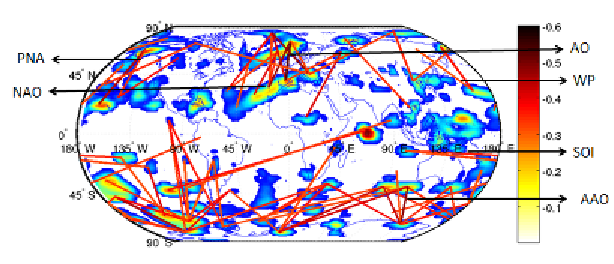Database Reference
In-Depth Information
5.1 Illustrative Application: Identifying
Atmospheric Teleconnections
Teleconnections are recurring patterns in climate anomalies connect-
ing two spatial regions that are far apart from each other. They have
been a subject of interest to climatologists due to the possibility of link-
ing changes in weather at one location to changes at another distant
location. Perhaps the most well known and widely studied teleconnec-
tion is the El Nino Southern Oscillation (ENSO). It represents a well
defined “sea-saw” spatial pattern of surface pressure in the tropics and
the subtropics exhibiting an oscillation.
Figure 15.8
shows the sea level
pressure anomaly (anomalies are constructed by removing the monthly
means from the data and are widely used in climate to reduce the effects
of seasonality) time series at Tahiti and Darwin which define the two
ends of the Southern Oscillation and exhibit negative correlation. The
El Nino climate phenomenon is known to be responsible for precipitation
and temperature anomalies worldwide.
Figure 15.7.
Map showing all the dipole edges in the NCEP Reanalysis dataset. Best
seen in color.
Scientists have been cognizant of the existence of a number of tele-
connections and historically they have been discovered by human ob-
servation or by using pattern analysis techniques such as the Empirical
Orthogonal Function (EOF) over a limited region. However there are
several limitations of the existing methods for finding these relation-
ships, and they require considerable research and insight on the part
of the domain experts involved. Knowledge of these teleconnections
and their interactions is particularly important for predicting climate
extreme events. For example, while the cold winter over Europe in
2010 could be largely explained by the North Atlantic Oscillation (NAO)
which is another teleconnection, and other local indices, the cold winter

